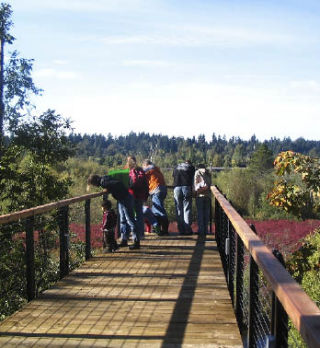When traveling off-Island to the east, we drive over it. Kayakers and canoers float through it, and hikers and joggers explore its trails. Students, teachers and parents of our elementary schools make field trips there every year. Thousands of migratory birds cross Mercer Island skies on the Pacific Flyway on their way to and from — you guessed it — the 320-acre Mercer Slough. And last Saturday, Oct. 11, the vital wetland ecosystem of the Mercer Slough got another boost, with the grand opening of the expanded Mercer Slough Environmental Education Center.
Just a hop, skip and a jump off Mercer Island in Bellevue, the wetlands Education Center is a collaborative effort of the Pacific Science Center and the city of Bellevue. The old Sullivan House that used to see approximately 8,000 students a year has been remodeled, and a cluster of new environmentally integrated buildings are now open, ready to usher in a whole new era of wetlands habitat appreciation and study to an estimated 40,000 visitors each year.
The new visitor center, community room, wetlab and two classrooms at the Mercer Island Environmental Education Center are all “sustainably built.” Even around the drop-off area, where one might expect smooth concrete curbs, metal-caged blocks of rocks have been installed to help disperse water in natural flow patterns. Several rooftops on the buildings are “green,” coated with plants, soil and gravel to prevent excessive run-off and reduce warming. The materials used to construct all the buildings are recyclable, obtained from renewable local sources.
Am I a nature geek fogetting almost breathless with excitement over the view from the boardwalk? Perhaps what took my breath away was the red-painted autumn foliage stretching across the expansive slough, or maybe it was the dizzying drop-off at the boardwalk’s edge. The new buildings and boardwalks on the sloping site are raised on stilts to allow for rainwater to flow downhill unimpeded. To add to the heady atmosphere, there is also a Treehouse for visitors to climb higher in the forest canopy.
Stop by the visitor center for displays and photos on the history of the slough and the native peoples who traveled its waterways and lived off its abundant resources for thousands of years. Also pick up a copy of the “Native Plants Along the Bellefields Nature Trail” guide before you hit the trails. A special feature of the center is the new “Dragonfly” wetlab, where students can use equipment such as microscopes to examine bugs, soil, water samples and more. Further fundraising efforts are in the works to build an additional wetlab and classroom.
With the grand opening of the Mercer Slough Center, the Pacific Science Center has launched a wide variety of classes, internships and outreach programs for all ages. Whether it’s a B’Earthday Party with a Bug Safari or Animal Mania theme, or the upcoming Haunted Hikes in honor of Halloween, educational opportunities abound. Designed by Jones & Jones Architects, the Mercer Slough Environmental Education Center is a model for the future of both education and the preservation of our vital wildlife habitat and resources.




